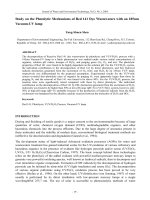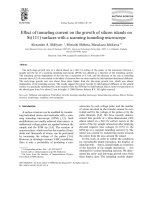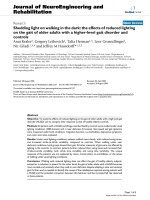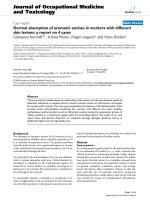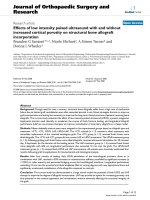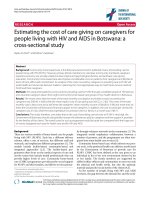SOLUTION OF ONE CONJECTURE ON INEQUALITIES WITH POWER-EXPONENTIAL FUNCTIONS
Bạn đang xem bản rút gọn của tài liệu. Xem và tải ngay bản đầy đủ của tài liệu tại đây (335.59 KB, 5 trang )
Volume 10 (2009), Issue 3, Article 72, 5 pp.
SOLUTION OF ONE CONJECTURE ON INEQUALITIES WITH
POWER-EXPONENTIAL FUNCTIONS
LADISLAV MATEJÍ
ˇ
CKA
INSTITUTE OF INFORMATION ENGINEERING, AUTOMATION AND MATHEMATICS
FACULTY OF CHEMICAL FOOD TECHNOLOGY
SLOVAK UNIVERSITY OF TECHNOLOGY IN BRATISLAVA
SLOVAKIA
Received 20 July, 2009; accepted 24 August, 2009
Communicated by S.S. Dragomir
ABSTRACT. In this paper, we prove one conjecture presented in the paper [V. Cîrtoaje, On some
inequalities with power-exponential functions, J. Inequal. Pure Appl. Math. 10 (2009) no. 1,
Art. 21. />Key words and phrases: Inequality, Power-exponential functions.
2000 Mathematics Subject Classification. 26D10.
1. INTRODUCTION
In the paper [1], V. Cîrtoaje posted 5 conjectures on inequalities with power-exponential
functions. In this paper, we prove Conjecture 4.6.
Conjecture 4.6. Let r be a positive real number. The inequality
(1.1) a
rb
+ b
ra
≤ 2
holds for all nonnegative real numbers a and b with a + b = 2, if and only if r ≤ 3.
2. PROOF OF CONJECTURE 4.6
First, we prove the necessary condition. Put a = 2 −
1
x
, b =
1
x
, r = 3x for x > 1. Then we
have
(2.1) a
rb
+ b
ra
> 2.
In fact,
2 −
1
x
3
+
1
x
3x
(
2−
1
x
)
= 8 −
12
x
+
6
x
2
−
1
x
3
+
1
x
6x−3
The author is deeply grateful to Professor Vasile Cîrtoaje for his valuable remarks, suggestions and for his improving some inequalities in
the paper.
193-09
2 LADISLAV MATEJÍ
ˇ
CKA
and if we show that
1
x
6x−3
> −6 +
12
x
−
6
x
2
+
1
x
3
then the inequality (2.1) will be fulfilled for
all x > 1. Put t =
1
x
, then 0 < t < 1. The inequality (2.1) becomes
t
6
t
> t
3
(t
3
− 6t
2
+ 12t − 6) = t
3
β(t),
where β(t) = t
3
− 6t
2
+ 12t − 6. From β
(t) = 3(t − 2)
2
, β(0) = −6, and from that there is
only one real t
0
= 0.7401 such that β(t
0
) = 0 and we have that β(t) ≤ 0 for 0 ≤ t ≤ t
0
. Thus,
it suffices to show that t
6
t
> t
3
β(t) for t
0
< t < 1. Rewriting the previous inequality we get
α(t) =
6
t
− 3
ln t − ln(t
3
− 6t
2
+ 12t − 6) > 0.
From α(1) = 0, it suffices to show that α
(t) < 0 for t
0
< t < 1, where
α
(t) = −
6
t
2
ln t +
6
t
− 3
1
t
−
3t
2
− 12t + 12
t
3
− 6t
2
+ 12t − 6
.
α
(t) < 0 is equivalent to
γ(t) = 2 ln t − 2 + t +
t
2
(t − 2)
2
t
3
− 6t
2
+ 12t − 6
> 0.
From γ(1) = 0, it suffices to show that γ
(t) < 0 for t
0
< t < 1, where
γ
(t) =
(4t
3
− 12t
2
+ 8t)(t
3
− 6t
2
+ 12t − 6) − (t
4
− 4t
3
+ 4t
2
)(3t
2
− 12t + 12)
(t
3
− 6t
2
+ 12t − 6)
2
+
2
t
+ 1
=
t
6
− 12t
5
+ 56t
4
− 120t
3
+ 120t
2
− 48t
(t
3
− 6t
2
+ 12t − 6)
2
+
2
t
+ 1.
γ
(t) < 0 is equivalent to
p(t) = 2t
7
− 22t
6
+ 92t
5
− 156t
4
+ 24t
3
+ 240t
2
− 252t + 72 < 0.
From
p(t) = 2(t − 1)(t
6
− 10t
5
+ 36t
4
− 42t
3
− 30t
2
+ 90t − 36),
it suffices to show that
(2.2) q(t) = t
6
− 10t
5
+ 36t
4
− 42t
3
− 30t
2
+ 90t − 36 > 0.
Since q(0.74) = 5.893, q(1) = 9 it suffices to show that q
(t) < 0 and (2.2) will be proved.
Indeed, for t
0
< t < 1, we have
q
(t) = 2(15t
4
− 100t
3
+ 216t
2
− 126t − 30)
< 2(40t
4
− 100t
3
+ 216t
2
− 126t − 30)
= 4(t − 1)(20t
3
− 30t
2
+ 78t + 15)
< 4(t − 1)(−30t
2
+ 78t) < 0.
This completes the proof of the necessary condition.
We prove the sufficient condition. Put a = 1 − x and b = 1 + x, where 0 < x < 1. Since the
desired inequality is true for x = 0 and for x = 1, we only need to show that
(2.3) (1 − x)
r(1+x)
+ (1 + x)
r(1−x)
≤ 2 for 0 < x < 1, 0 < r ≤ 3.
Denote ϕ(x ) = (1− x)
r(1+x)
+(1 + x)
r(1−x)
. We show that ϕ
(x) < 0 for 0 < x < 1, 0 < r ≤ 3
which gives that (2.3) is valid (ϕ(0) = 2).
ϕ
(x) = (1 − x)
r(1+x)
r ln(1 − x) − r
1 + x
1 − x
+ (1 + x)
r(1−x)
r
1 − x
1 + x
− r ln(1 + x)
.
J. Inequal. Pure and Appl. Math., 10(3) (2009), Art. 72, 5 pp. />SOLUTION OF ONE CONJECTURE 3
The inequality ϕ
(x) < 0 is equivalent to
(2.4)
1 + x
1 − x
r
1 − x
1 + x
− ln(1 + x)
≤ (1 − x
2
)
rx
1 + x
1 − x
− ln(1 − x)
.
If δ(x) =
1−x
1+x
− ln(1 + x) ≤ 0, then (2.4) is evident. Since δ
(x) = −
2
(1+x)
2
−
1
1+x
< 0
for 0 ≤ x < 1, δ(0) = 1 and δ(1) = − ln 2, we have δ(x) > 0 for 0 ≤ x < x
0
∼
=
0.4547.
Therefore, it suffices to show that h(x) ≥ 0 for 0 ≤ x ≤ x
0
, where
h(x) = rx ln(1 − x
2
) − r ln
1 + x
1 − x
+ ln
1 + x
1 − x
− ln(1 − x)
− ln
1 − x
1 + x
− ln(1 + x)
.
We show that h
(x) ≥ 0 for 0 < x < x
0
, 0 < r ≤ 3. Then from h(0) = 0 we obtain h(x) ≥ 0
for 0 < x ≤ x
0
and it implies that the inequality (2.4) is valid.
h
(x) = r ln(1 − x
2
) − 2r
1 + x
2
1 − x
2
+
3 − x
(1 − x)(1 + x − (1 − x) ln(1 − x ))
+
3 + x
(1 + x)(1 − x − (1 + x) ln(1 + x))
.
Put A = ln(1 + x) and B = ln(1 − x). The inequality h
(x) ≥ 0, 0 < x < x
0
is equivalent to
(2.5) r(2x
2
+ 2 − (1 − x
2
)(A + B)) ≤
3 − 2x − x
2
1 − x − (1 + x)A
+
3 + 2x − x
2
1 + x − (1 − x)B
.
Since 2x
2
+ 2 − (1 − x
2
)(A + B) > 0 for 0 < x < 1, it suffices to prove that
(2.6) 3(2x
2
+ 2 − (1 − x
2
)(A + B)) ≤
3 − 2x − x
2
1 − x − (1 + x)A
+
3 + 2x − x
2
1 + x − (1 − x)B
and then the inequality (2.5) will be fulfilled for 0 < r ≤ 3. The inequality (2.6) for 0 < x < x
0
is equivalent to
(2.7) 6x
2
− 6x
4
− (9x
4
+ 13x
3
+ 5x
2
+ 7x + 6)A − (9x
4
− 13x
3
+ 5x
2
− 7x + 6)B
− (3x
4
+ 6x
3
− 6x − 3)A
2
− (3x
4
− 6x
3
+ 6x − 3)B
2
− (12x
4
− 12)AB − (3x
4
− 6x
2
+ 3)AB(A + B) ≤ 0.
It is easy to show that the following Taylor’s formulas are valid for 0 < x < 1:
A =
∞
n=0
(−1)
n
n + 1
x
n+1
, B = −
∞
n=0
1
n + 1
x
n+1
,
A
2
=
∞
n=1
2(−1)
n+1
n + 1
n
i=1
1
i
x
n+1
, B
2
=
∞
n=1
2
n + 1
n
i=1
1
i
x
n+1
,
AB = −
∞
n=0
1
n + 1
2n+1
i=1
(−1)
i+1
i
x
2n+2
.
Since
A
2
+ B
2
=
n=1,3,5,
4
n + 1
n
i=1
1
i
x
n+1
J. Inequal. Pure and Appl. Math., 10(3) (2009), Art. 72, 5 pp. />4 LADISLAV MATEJÍ
ˇ
CKA
and
4
n + 1
n
i=1
1
i
≤
4
n + 1
1 +
n − 1
2
= 2,
we have
A
2
+ B
2
=
n=1,3,5,
4
n + 1
n
i=1
1
i
x
n+1
= 2x
2
+
11
6
x
4
+
137
90
x
6
+
n=7,9,
4
n + 1
n
i=1
1
i
x
n+1
< 2x
2
+
11
6
x
4
+
137
90
x
6
+ 2
n=7,9,
x
n+1
= 2x
2
+
11
6
x
4
+
137
90
x
6
+
2x
8
1 − x
2
.
From this and from the previous Taylor’s formulas we have
(2.8) A + B > −x
2
−
1
2
x
4
−
1
3
x
6
−
1
4
x
8
1 − x
2
,
(2.9) A − B > 2x +
2
3
x
3
+
2
5
x
5
+
2
7
x
7
,
(2.10) A
2
+ B
2
< 2x
2
+
11
6
x
4
+
137
90
x
6
+
2x
8
1 − x
2
,
(2.11) A
2
− B
2
< −2x
3
−
5
3
x
5
,
(2.12) AB < −x
2
−
5
12
x
4
for 0 < x < 1.
Now, having in view (2.12) and the obvious inequality A + B < 0, to prove (2.7) it suffices to
show that
6x
2
− 6x
4
− (6 + 5x
2
+ 9x
4
)(A + B) + (7x + 13x
3
)(B − A) + (3 − 3x
4
)(A
2
+ B
2
)
+ (6x − 6x
3
)(A
2
− B
2
) − (12 − 12x
4
)
x
2
+
5
12
x
4
+
x
2
+
5
12
x
4
(3 − 6x
2
+ 3x
4
)(A + B) ≤ 0.
By using the inequalities (2.10), (2.11), the previous inequality will be proved if we show that
6x
2
− 6x
4
− (6 + 5x
2
+ 9x
4
)(A + B) + (7x + 13x
3
)(B − A)
+ (3 − 3x
4
)
2x
2
+
11
6
x
4
+
137
90
x
6
+
2x
8
1 − x
2
− (6x − 6x
3
)
2x
3
+
5
3
x
5
− (12 − 12x
4
)
x
2
+
5
12
x
4
+
x
2
+
5
12
x
4
(3 − 6x
2
+ 3x
4
)(B + A) ≤ 0,
J. Inequal. Pure and Appl. Math., 10(3) (2009), Art. 72, 5 pp. />SOLUTION OF ONE CONJECTURE 5
which can be rewritten as
(2.13) −
35
2
x
4
+
377
30
x
6
+
19
2
x
8
−
137
30
x
10
+ 6(x
8
+ x
10
)
− (A + B)
6 + 2x
2
+
55
4
x
4
−
1
2
x
6
−
5
4
x
8
+ (7x + 13x
3
)(B − A) ≤ 0.
To prove (2.13) it suffices to show
(2.14) − 8x
2
−
259
6
x
4
+
357
20
x
6
+
1841
120
x
8
+
337
420
x
10
−
19
24
x
12
−
5
12
x
14
+
x
8
1 − x
2
3
2
+
1
2
x
2
+
55
16
x
4
−
1
8
x
6
−
5
16
x
8
< 0.
It follows from (2.8) and (2.9). Since 0 < x <
1
2
we have
1
1−x
2
<
4
3
. If we show
ε(x) = −8x
2
−
259
6
x
4
+
357
20
x
6
+
1841
120
x
8
+
337
420
x
10
−
19
24
x
12
−
5
12
x
14
+ 2x
8
+
2
3
x
10
+
55
12
x
12
−
1
6
x
14
−
5
12
x
16
< 0,
then the inequality (2.14) will be proved. From x
6
< x
4
, x
8
< x
4
, x
10
< x
4
and x
12
< x
4
, we
obtain that
ε(x) < −8x
2
−
19
7
x
4
−
7
12
x
14
−
5
12
x
16
< 0.
This completes the proof.
REFERENCES
[1] V. CÎRTOAJE, On some inequalities with power-exponential functions, J. Inequal. Pure Appl. Math.,
10(1) (2009), Art. 21. [ONLINE: />J. Inequal. Pure and Appl. Math., 10(3) (2009), Art. 72, 5 pp. />
